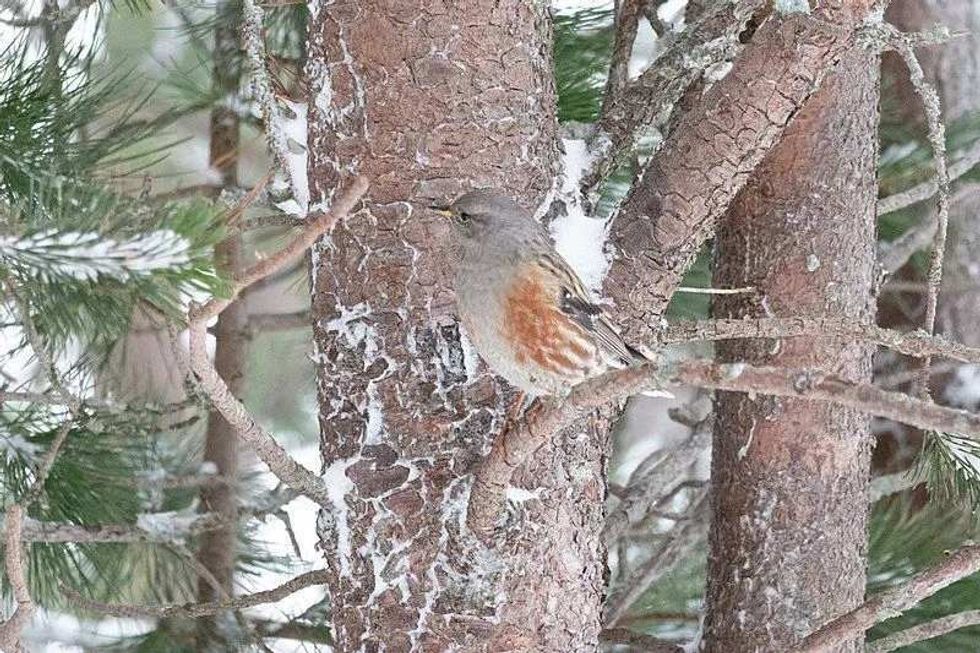The Alpine Accentor (Prunella collaris) is a passerine bird with its resident distribution range across Southern Europe, Lebanon, and Asia, while some vagrants are found up north in Great Britain. These birds have black-brown wing coverts, short, yellow-ish beaks, gray heads, white-mottled throat, and rusty flanks.
The Alpine Accentor lives in mountain areas at an altitude of around 6,500 ft (2000 m). However, some of the birds are observed moving to lower altitudes during the winter.
Accentors are polygynandrous, and during the breeding season, females will have one to two broods with different males, while the males repeat the pattern as well.
Females lay three to five eggs light-blue eggs, which she incubates for 13-14 days. Both sexes care for the young, and the male will visit all the females he mated with and help feed the chicks.
The Alpine Accentor feeds on the ground and mainly on insects, but during the winter, they nibble on seeds as well. In addition, this bird species has a stable population without any major, direct threats. As a result, this species is considered Least Concern according to the IUCN conservation status.
If you enjoy learning more about birds, take a look at the Mockingbird and the Northern Shrike.
Alpine Accentor Interesting Facts
What type of animal is an Alpine Accentor?
The Alpine Accentor (Prunella collaris) is a resident bird species from Southern Europe, Asia, and Africa.
What class of animal does Alpine Accentor belong to?
This bird belongs to the class of Aves under the family Prunellidae and genus Prunella.
How many Alpine Accentors are there in the world?
According to the IUCN database, the mature individuals of this species have a population range between 1,000,000-2,999,999, which means there are around 25,000-40,000 breeding pairs.
Where does Alpine Accentor live?
The Alpine Accentor (Prunella collaris) is found throughout Southern Europe in countries like Portugal, Hungary, Italy, Belgium, Luxembourg, Greece, France, and Spain. In Asia, they are found across Lebanon, Japan, Korea, Nepal, Afghanistan, China, Morocco, Russia, and Turkey.
In North Africa, this species is spotted throughout Tunisia and Israel. Sometimes, vagrants are found far up north in the United Kingdom, Sweden, Norway, Finland, and Denmark.
What is an Alpine Accentor habitat?
Accentors are found at an elevation above 6,600 ft (2,000 m) up to 16,400 ft (5,000 m) among mountain ranges, inland cliffs, and temperate grassland and shrubland.
Who does Alpine Accentor live with?
The exact living pattern and distribution of accentors are unknown. However, breeding individuals of around three to four females and males each, which occupy a common home range.
How long does Alpine Accentor live?
Although the lifespan of both the Alpine Accentor (Prunella collaris) sexes is unknown, the maximum age recorded across Europe is around eight years, while in Switzerland it is seven years.
How do they reproduce?
The Alpine Accentor (Prunella collaris) bird species are polygynandrous, which means their mating system involves multiple mates. The breeding groups are found with three to four males and females each.
Usually, males are responsible for protecting the territory in which females have built nests. This bird species has alpha males who will stop the females from mating with weaker or younger males.
The broods of these birds have shown mixed paternity, but each nest contains eggs that belong to the same female. These birds build a cup-shaped nest that is lined with moss and situated low in rock crevices or bushes.
The female lays three to five light-blue eggs that are incubated over 13-14 days. Males also take responsibility and feed the young from the nest that belongs to all the female partners.
What is their conservation status?
Since these accentors have a stable population, the IUCN has declared that they have the conservation status of Least Concern.
Alpine Accentor Fun Facts
What does the Alpine Accentor look like?
The Alpine Accentor (Prunella collaris) bird species has a similar brown-gray physical description as a Grasshopper Sparrow. Both the sexes look alike, but males may have a slightly richer shade than females.
These resident birds have a gray head and throat with a white-brown mottled pattern from under the beak and throughout the throat and neck region. They have rusty-brown flanks with black-brown wings coverts ending with white tips.
This bird also has a black-tipped beak with a bright yellow base, brown eyes, and orange-brown feet. They have a striking distribution of dark blackish stripes on their wings and flanks that extend into the tail feathers as well.
How cute are they?
These accentors from Europe, Asia, and Africa have small bodies with a dark distribution of beautiful stripes, making them look quite adorable.
How do they communicate?
The exact way in which these birds communicate with each other is unknown. However, they have been heard voicing a call similar to that of the Snow Bunting, like a pleasant 'prrrrriittt' ring-like song. They also make a chattering, low-pitched melody similar to the call description of the Skylark. They also make a repetitive, noisy 'tchrt' sound.
How big is the Alpine Accentor?
These ground-dwelling accentors are around 5.9-6.9 in (15-17.5 cm) in length, which is similar to that of a Robin.
How fast can an Alpine Accentor fly?
The flight speed of the Alpine Accentor (Prunella collaris) is unknown.
How much does an Alpine Accentor weigh?
The Alpine Accentor (Prunella collaris) weighs around 0.9-1.2 oz (25.5-35 g).
What are the male and female names of the species?
The male and female birds share a common name.
What would you call a baby Alpine Accentor?
The babies of these birds can be called chicks or juveniles like any other bird.
What do they eat?
The Alpine Accentor (Prunella collaris) is omnivorous and is seen feeding on insects, larvae, and small invertebrates like ground beetles, flies, caterpillars, spiders, and moths.
Are they dangerous?
These are small birds that live high up in the mountains. They rarely come in direct contact with humans or other animals, and if they do, they are entirely harmless. However, males may get aggressive when protecting their breeding territories.
Would they make a good pet?
These birds are meant for the wild, especially higher altitudes. That is the reason why they would not be ideal pets.
Did you know...
These accentors were described in 1769 by naturalist Giovanni Antonio Scopoli.
There are around nine recognized subspecies of the Alpine Accentor (Prunella collaris).
The breeding hotspots of these birds are found in the mountains of the Caucasus, Switzerland, and the Pyrenees.
How many eggs do the Alpine Accentor lay?
The sparrow-like Alpine Accentor (Prunella collaris) female has a clutch size of around three to five. These birds have more than one mate, and their broods often show mixed paternity.
Do Alpine Accentors migrate?
The ground-dwelling Alpine Accentor (Prunella collaris) is a sedentary bird that may descend to lower altitudes of around 5,905.5 ft (1,800 m) during the winter. Some vagrant birds wander far up north and are found in Great Britain.
Here at Kidadl, we have carefully created lots of interesting family-friendly animal facts for everyone to discover! For more relatable content, check out these Gila Woodpecker Facts and Red Finch Facts pages.
You can even occupy yourself at home by coloring in one of our free printable bird coloring pages.









